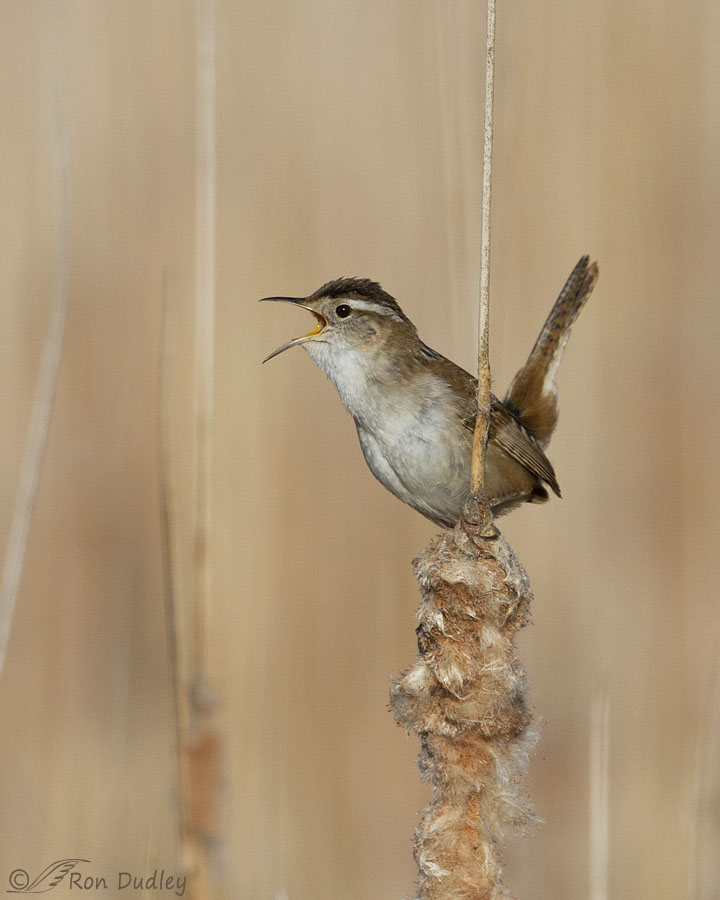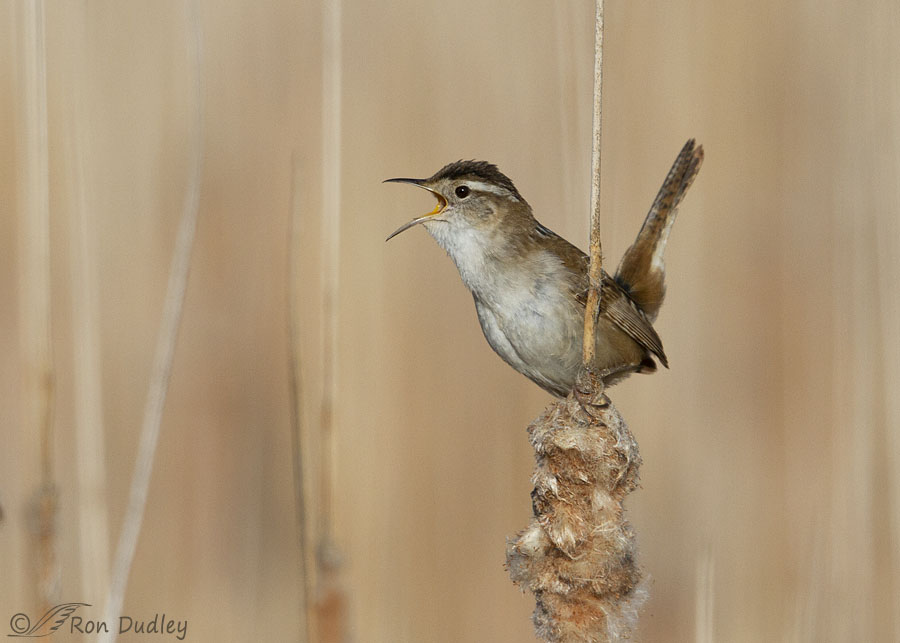I can’t imagine a more prolific songster than the Marsh Wren.

1/4000, f/6.3, ISO 500, Canon 7D, Canon EF 500mm f/4L IS II USM + EF 1.4 III Extender, not baited, set up or called in
This is an older photo of a Marsh Wren singing atop a cattail at Bear River MBR. This and others I took of the same bird that morning are among my favorite photos of the species, for a variety of reasons including the out of focus background that has no distracting elements but still strongly suggests the typical habitat of the species. And for the singing behavior of course.
I don’t know the sex of this bird but both sexes sing and males learn between 50 and 200 song types which they sing all day and all night throughout the summer.

A horizontal composition of the same photo if you prefer.
In the marshes neighboring adult males engage in complex and intense countersinging duels, singing almost continuously day and night in their bid for reproductive success.
With apologies to the likes of Wyatt Earp and Ike Clanton I like to think of it as the songfight at the cattail corral.
Ron


Sensational shots Ron! Thanks for sharing!
Charlotte Norton
Thanks, Charlotte.
Love the photos; so many shades of brown.
We’re in the minority here, but I like the horizontal version because, in keeping with your old west theme, it brings to mind “Give me land, lots of land, under starry skies above…”. Your’e welcome for the ear worm.
Immediately, the next line in the song came to mind, Lyle. And the tune.
There are worse ear worms. It could have been Barry Manilow…
I can’t imagine a better image of the species than the first one – outstanding!
Thanks very much, Gary.
Hooray for the songster. All of them.
Vertical crop for me.
And thank you.
Thanks, EC.
Looks like we’re in their wintering range, so no Songhetti Westerns for us. As usual, I like the vertical crop better.
I managed to stay both un-peed-upon and upright with four dogs yesterday, although the two Pit Bulls and the Dogue de Bordeaux-mix with the wicked underbite managed to slime me up pretty well, slobber-wise. (Totally worth it!)
You’re a glutton for punishment when it comes to disadvantaged critters, Marty. Good thing for them though!
I ADORE them! ❤️🐶
I like the vertical framing because it reminds me of the vertical world that marsh wrens inhabit. We often hear their chattering call in the cattails of Farmington Bay, but they can be difficult to spot.
Excellent rationale for your preference, Joel.
I love the first. I don’t know why, but I got a flash of a photo of a famous 19th-century singer whose name is long gone from my brain, singing in a Victorian parlor with cream-silk walls.
I love flash memories like that and the fact that my brain has made a connection between two entirely separate beings. Thanks!
Thanks a lot, Sallie, Now I’m probably going to have to do some research, just to satisfy my curiosity…
I wouldn’t bother, Ron. It could be a made-up memory, for all I know. I do have an old sepia studio photo of a woman in a long wren-colored gown – looks more like a pigeon – with cream silk walls behind her. She isn’t singing, though. I think she just got through reaming someone out! Elegantly of course!
Up to 200 songs, that’s amazing. I can’t remember the words to one songs😆
Beautiful pictures of a talented guy.
I have trouble with the words to songs too, Diana. Not only remembering them but getting them right in the first place.
I was aware that many birds, like mocking birds, have many songs and use the number and style of variation to convince members of the opposite sex that they are the best mate. I had no idea that marsh wrens did this, and especially to the extent of 50 to 200 (!!!) songs.
I enjoy your photos, but the bits of information are an important part of keeping me coming back.
“the bits of information are an important part of keeping me coming back”
That’s very good to know, Nancy. Thank you.
“Songfight” ? We should definitely be treated to more of THOSE than the
bang-bang type– LOVE them little songsters– and I had no idea that they
learn so many melodic lines. Thanks for that interesting info !
Thanks, Kris. Gotta wonder how they learn and remember so many complex songs.
Wow! 200 songs. Very impressive. Love the creamy bokeh and its beautiful colour that complements the wren’s colouration so well. It’s hard to tell for sure on a small screen but I think I like the vertical composition best.
I agree, Granny Pat. I’ll take the vertical composition hands down.
Yup. I should have said why but didn’t so I’ll remedy that now: the vertical composition mirrors the direction of the lines of the reeds and the line made by the bird on the cattail. For.my eye, repetition of strong line/direction makes.for a stronger composition. (But that is just me and for some people I suppose the tension of horizontal vs vertical might be more appealing. )To each his own I guess. And yes, the info and tidbits supplied with your photos is what elevates your blog above the average pretty pic “norm” for me too.
Cattail Corral? Ow! Owowowow!
Lololol! I really like the wrens. They come across as imperious little busybodies.
They sure do!
Love this photo! I prefer the horizontal version because I like the patterns of and and various tilts of the cattails in the background. It creates the feeling of the space of the marsh without distracting from the Wren.
Thanks for sharing your preference, Joanne.
Little birds with bodacious voices win everyone’s hearts 🙂
Maybe not everyone’s, Terri. Some folks find the “song” of Marsh Wrens to be less than pleasant. Personally I love it, if for nothing else than its persistence and enthusiasm.
I love these shots! Especially the vertical composition. Emphasizes the upright posture and is just more artistic to my eye, with that sculptural cattail on the left.
Mary, I also prefer the vertical but I thought I’d include the horizontal for those with different tastes.
Don’t believe I’ve ever seen/heard one – we seem to be borderline for breeding. Sure can tell it’s putting it’s all into it in the photo tho! VBG! The wren really stands out against that background while still “blending” with it. 🙂
Judy, the range map shows them in your area but come to think of it I don’t remember seeing them that for north in MT either. They’re probably there, I just haven’t seen them…
Great shots, love em!
Good. Thanks, Dick.